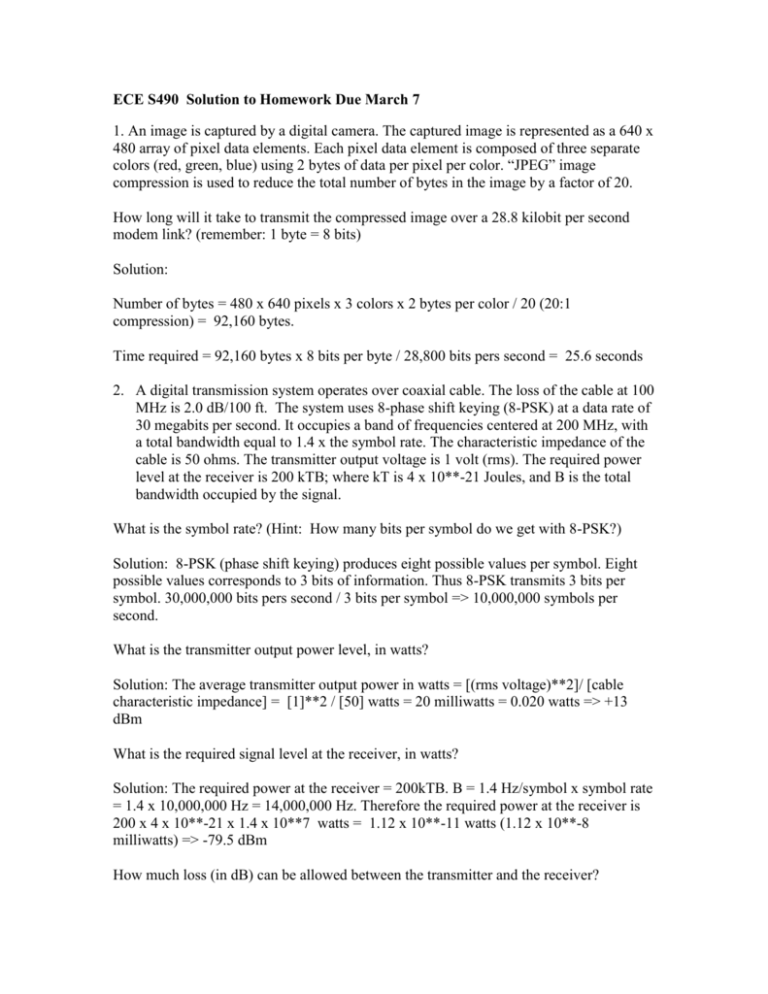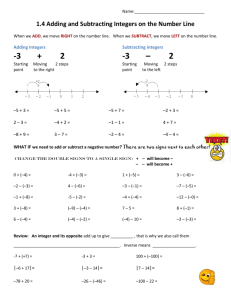Solution 8
advertisement

ECE S490 Solution to Homework Due March 7 1. An image is captured by a digital camera. The captured image is represented as a 640 x 480 array of pixel data elements. Each pixel data element is composed of three separate colors (red, green, blue) using 2 bytes of data per pixel per color. “JPEG” image compression is used to reduce the total number of bytes in the image by a factor of 20. How long will it take to transmit the compressed image over a 28.8 kilobit per second modem link? (remember: 1 byte = 8 bits) Solution: Number of bytes = 480 x 640 pixels x 3 colors x 2 bytes per color / 20 (20:1 compression) = 92,160 bytes. Time required = 92,160 bytes x 8 bits per byte / 28,800 bits pers second = 25.6 seconds 2. A digital transmission system operates over coaxial cable. The loss of the cable at 100 MHz is 2.0 dB/100 ft. The system uses 8-phase shift keying (8-PSK) at a data rate of 30 megabits per second. It occupies a band of frequencies centered at 200 MHz, with a total bandwidth equal to 1.4 x the symbol rate. The characteristic impedance of the cable is 50 ohms. The transmitter output voltage is 1 volt (rms). The required power level at the receiver is 200 kTB; where kT is 4 x 10**-21 Joules, and B is the total bandwidth occupied by the signal. What is the symbol rate? (Hint: How many bits per symbol do we get with 8-PSK?) Solution: 8-PSK (phase shift keying) produces eight possible values per symbol. Eight possible values corresponds to 3 bits of information. Thus 8-PSK transmits 3 bits per symbol. 30,000,000 bits pers second / 3 bits per symbol => 10,000,000 symbols per second. What is the transmitter output power level, in watts? Solution: The average transmitter output power in watts = [(rms voltage)**2]/ [cable characteristic impedance] = [1]**2 / [50] watts = 20 milliwatts = 0.020 watts => +13 dBm What is the required signal level at the receiver, in watts? Solution: The required power at the receiver = 200kTB. B = 1.4 Hz/symbol x symbol rate = 1.4 x 10,000,000 Hz = 14,000,000 Hz. Therefore the required power at the receiver is 200 x 4 x 10**-21 x 1.4 x 10**7 watts = 1.12 x 10**-11 watts (1.12 x 10**-8 milliwatts) => -79.5 dBm How much loss (in dB) can be allowed between the transmitter and the receiver? Solution: Allowable loss = +13 dBm – [ -79.5 dBm) = 92.5 dB What is the loss of the cable at the center frequency of the signal (dB/100ft)? Solution: The loss at 200 MHz is [2 dB/100 feet] x [200/100]**.5 = 2.83 dB/100 ft How much cable (in feet) can we insert between the transmitter and the receiver? Solution: Allowable length of cable = 92.5 dB / [2.83 dB/100 ft] = 32.7 x 100 ft = 3270 ft 3. A digital fiber optic link in an audio system operates at a wavelength of 600 nm, using a multimode plastic fiber. The transmitter in the fiber optic link is a light emitting diode (LED) that has a total average output power (when the link is being used) of 1 milliwatt. The coupling loss from the LED into the fiber is 16 dB. The receiver in the fiber optic link requires a signal energy of 50,000 photons per received pulse in order to produce the desired error rate. The photon energy at this wavelength is ~3 x 10**-19 Joules. The fiber loss is 2 dB/ meter (i.e., 2000 dB/km). The pulse spreading in the fiber, due to different rays travelling at different angles along the fiber is 200 ns/km. The link operates at 10 megabits per second. How much power (in milliwatts) does the transmitter launch into the fiber? Solution: 16 dB of coupling loss corresponds to a power coupling factor of (1/39.8) = 0.025. Thus the average power launched into the fiber is 1 milliwatt x 0.025 = 0.025 milliwatts. We will assume that “average power when the link is being used” means the average power when half the transmitted pulses are on, and half the transmitted pulses are off. [You need to state whatever you think this means, if you think it means something different] How much power (in milliwatts) is required at the receiver? Solution: The power required at the receiver (assuming half the pulses are on and half the pulses are off) is [0.5 received pulse per bit] x 50,000 photons per received pulse x 3 x 10**-19 J/photon x 10,000,000 bits per second = .000075 milliwatts How much loss can the fiber have (in dB), while still providing enough power at the receiver? Solution: Allowable loss = 10 log [ .025 milliwatts / .000075 milliwatts] = 25.2 dB How long can the fiber be (in meters)? Solution: The allowable fiber length (limited by loss) = 25.2 dB/ 2 db per meter = 12.6 meters At what data rate would the allowable transmission distance, limited by loss, equal the allowable transmission distance, limited by pulse spreading? (Assume that the pulse spreading must not exceed 0.5 x the spacing between pulses) Solution: Pulse spreading limited operation would occur when the pulse spreading in a given length of fiber exceeds the allowable loss in that same length of fiber. At 10 Mbps, the pulse spacing = 1/[10 Mbps] = 10**-7 seconds (100 nanoseconds). The allowable pulse spreading at 10 Mbps is 0.5 x 10**-7 seconds = 50 nanoseconds. At 10 Mbps the allowable fiber length, limited by pulse spreading is 50 nanoseconds / [ 200 nanoseconds per kilometer] = 0.25 kilometers = 250 meters. The allowable loss decreases by 3 dB every time we double the bit rate. Thus the allowable distance, limited by loss, decreases by 1.5 meters every time we double the bit rate. [3 dB / 2 dB per meter = 1.5 meters] The allowable distance, limited by pulse spreading, decreases by a factor of 2 every time the bit rate doubles. If we double the data rate to 20 Mbps, the loss-limited distance decreases from 12.6 meters to 12.6 – 1.5 = 11.1 meters. The pulse-spreading-linited distance gets cut in half from 250 meters to 125 meters. If we keep doubling the data rate until we get to 640 Mbps, then the allowable distance limited by loss decreases by 9 meters (6 doublings x 3 dB per doubling/ 2 dB per meter) to 3.6 meters; while the allowable distance, limited by pulse spreading decreases by a factor of 64 to 3.9 meters. The crossover point occurs at around 900 Mbps, where the loss-limited distance is approximately 2.8 meters, and the pulse-spreading limited distance is also approximately 2.8 meters 3. A switch has 4096 inputs and 4096 outputs. How many crosspoints are needed if the switch is constructed as a simple rectangular array of crosspoints? Solution: 4096 x 4096 = 16,777,216 How many crosspoints are needed if the switch is constructed by using a set of 64 x 256 input switching modules and a corresponding set of 256 x 64 output switching modules, with four links between each input switching module and each output switching module? Solution: Each module has 64 x 256 = 16,384 crosspoints. There are two columns of modules, one at the input and one at the output. Since the switch has 4096 inputs and outputs, and each module in the input has 64 inputs and each module in the output column has 64 outputs…we will therefore need 64 modules in each column. Thus the total number of crosspoints needed is 2 columns x 64 modules per column x 16,384 crosspoints per module = 2,097,152 crosspoints How many crosspoints are needed if the switch is implemented with a Banyon switching fabric, using 2x2 switching modules? Solution: We will need 12 columns (2**12 = 4096), each containing 2048 modules. There are 4 crosspoints per module (2 x 2). Thus we will need 12 columns x 2048 modules x 4 crosspoints per module = 98,304 crosspoints







